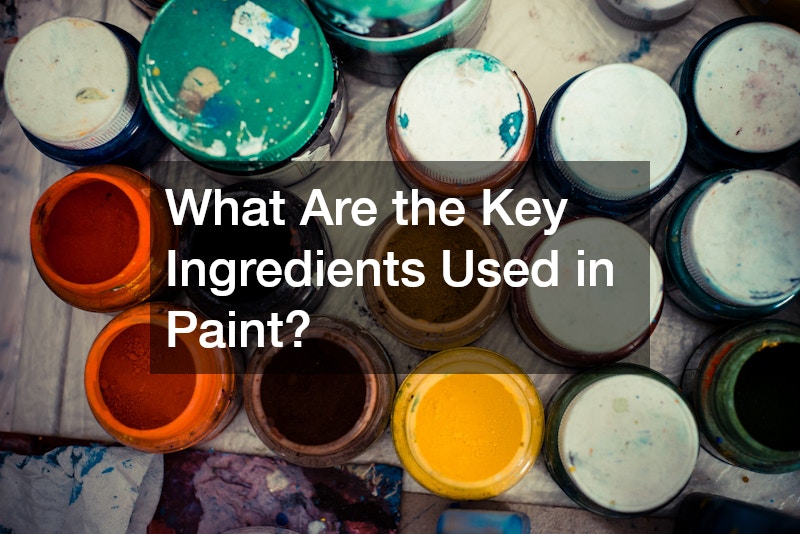Paint is a versatile product with a wide array of applications ranging from home décor to industrial coatings. It serves a variety of functions such as protection, decoration, and identification. Understanding the composition of paint is essential for anyone interested in using or choosing the right type of paint for a specific purpose.
1. Pigments: The Core of Paint
Pigments are finely ground particles that provide the paint with its color and opacity. They can be organic or inorganic, with each type offering distinctive characteristics in terms of durability, weather resistance, and color fastness.
Organic pigments are usually brighter and more vibrant, while inorganic pigments tend to be more resilient and long-lasting.
In addition to these basic types, specialty pigments offer effects such as pearlescence and fluorescence. The choice of pigments greatly influences the final appearance of the paint. For instance, in residential paint, titanium dioxide is a common white pigment that provides excellent coverage and brightness.
There are also environmental considerations when selecting pigments, as some may contain heavy metals that can be harmful. Innovations in eco-friendly pigments are helping reduce these impacts while maintaining high performance. This trend highlights the dynamic nature of the paint industry in responding to both consumer preferences and environmental demands.
2. Binders: The Glue that Holds Paint Together
Binders, often referred to as resins, are responsible for providing adhesion, durability, and integrity of the paint film after it has dried. They are typically composed of natural oils, alkyds, or synthetic polymers such as acrylic, vinyl, and polyurethane. The binder determines the paint’s drying time, flexibility, gloss level, and eventual hardness.
Acrylic binders are widely used due to their excellent weather resistance and flexibility, which makes them ideal for exterior applications. In contrast, alkyd-based paints tend to have superior hardness and gloss, making them a popular choice for indoor settings where durability is crucial. The selection of a binder should always consider the paint’s intended use, whether it be for an indoor wall or an outdoor metal surface.
Moreover, with advancements in paint technology, water-based binders are becoming increasingly popular due to their low odor, easy cleanup, and lower environmental impact compared to solvent-based alternatives. This shift not only benefits the environment but also enhances user safety. Paint formulation has indeed evolved, with a greater emphasis on sustainability without compromising performance.
3. Solvents: The Carriers of Paint
Solvents are a crucial component in paint that work to dissolve the binder and create a liquid solution that can be applied easily. They dictate the paint’s application properties such as flow, leveling, and drying time. Common solvents include water for water-based paints and mineral spirits or turpentine for oil-based paints.
Water-based paints are often preferred for residential use due to their low volatile organic compound (VOC) emissions, which contribute to better indoor air quality. Despite the popularity of water-based solvents due to environmental considerations, oil-based paints remain valued for their high durability and finish quality. Thus, the choice between water or oil-based solvents often comes down to balancing environmental impact with desired performance traits.
Understanding the role of solvents in paint not only helps in achieving the right application but also in assessing the environmental footprint of the paint product. As regulations around VOC emissions become stricter, the paint industry continues to innovate in developing low-VOC solutions that meet both regulatory and consumer demands. This reflects broader trends in the industry towards sustainable and health-friendly products.
4. Additives: The Enhancers of Paint
Additives are the unsung heroes in paint formulations, as they contribute significantly to the paint’s overall performance. They can improve properties such as flow, leveling, surface tension, and UV resistance. Common additives include thickeners to improve consistency, mildewcides to prevent mold growth, and UV stabilizers to prevent color fading.
The choice of additives is often fine-tuned to meet the specific requirements of different paint applications. For instance, exterior paints may include more UV stabilizers and mildewcides, while interior paints might emphasize odor-reducing agents. This customization allows for paints that are better suited for specialized tasks while maintaining a focus on user safety and environmental impact.
As the paint industry progresses, the formulation and development of new additives continue to advance. These innovations not only help improve paint performance but also contribute to environmentally friendly products. With additive technology playing such an integral role, it demonstrates how chemistry can enhance everyday products like paint.
Understanding the key ingredients of paint, including pigments, binders, solvents, and additives, is essential for making informed decisions about paint usage. Each component plays a distinct role, contributing to the paint’s color, durability, ease of application, and overall performance. As trends move towards sustainability, innovations within these ingredients highlight the industry’s commitment to meeting both functional and environmental standards.
The type of paint chosen can greatly impact the final finish and longevity of a project, whether it is a residential renovation or a commercial application. By considering the composition of paint, the right product can be selected to meet specific needs and preferences. As the demand for environmentally friendly and high-performance paints increases, the paint industry continues to evolve with innovative solutions.
Paint, with its multifaceted role across industries and homes, is a product that is essential in everyday life. Understanding its composition not only enhances its application but also ensures responsible and sustainable use. Through ongoing advancements in paint technology, the future of paint looks brighter and more sustainable than ever before.


